Star Wars is driven by aesthetics. Part of the look of the franchise that is front and center has always been the blasters.

For me, there are a lot of things that go into making a Star Wars blaster look like it fits into the setting. First is that most of the blasters and accessories use real life guns as a basis, and since the original trilogy came out between 1977 and 1983, the kinds of props that could be made in that real life era cemented what looks like it belong in Star Wars; a super modern tactical gun or accessory made in the 2000s is going to stick out like a sore thumb.
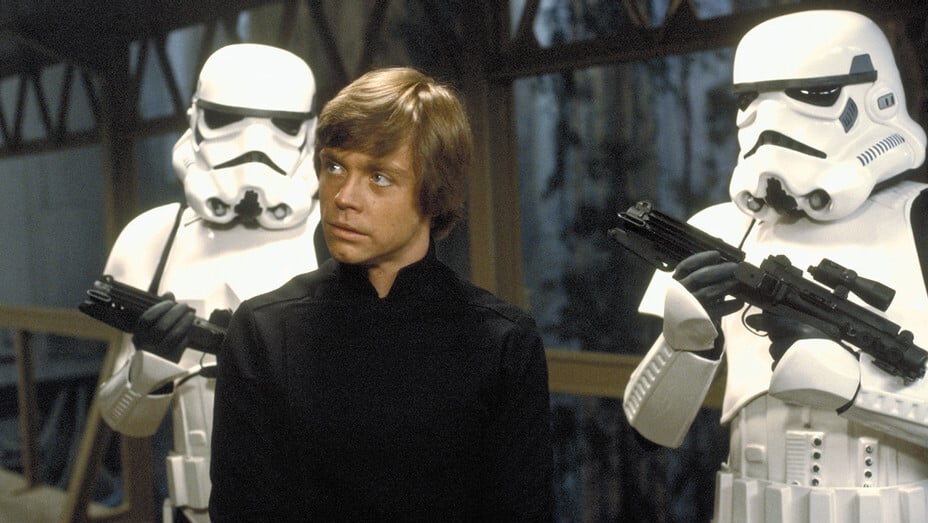
While aspects of the original gun are going to show through, it usually isn’t obvious for a casual viewer on a quick glance to pick up what is under all the greeble. After that is kind of an x factor about the greeble and prop construction. A good Star Wars blaster usually looks more metal, with maybe a hint of wood, than plastic in construction. The lines and aesthetic should fit the user. A dignified character who doesn’t normally fight should have something smaller and more ornate while a battle harder trooper has something mass produced, and a low life type should have something that looks worn and cobbled together.
I limited to just live action appearances. I looked through all of the live action Star Wars material- the nine main movies, Rogue One, Solo, Andor, Book Of Boba Fett, Ashoka, Kenobi, and The Mandalorian and picked out five of the best and worst examples of Star Wars blasters. It was hard to narrow down the list, and there was a lot of examples that just barely missed the cut. This list is all personal and subjective opinion, with a lot of guidelines but as always aesthetic judgments are never an objective exercise. I’m also going to mostly pick on props which I know caught my eye when I watched the movies and shows, since there are plenty of lower quality props that stayed in holsters or were only vaguely in the background, for those I figure out of sight and out of mind compared to props that spent more time in the middle of the frame.
Starting with some of the best Star Wars blasters.
1. Han Solo’s DL-44
Han’s DL-44, based on a real life C96 Mauser, is iconic for the character and a perfect example of balancing letting the real prop underneath show through with adding just the right amount of greeble. One of the most recognizable parts of a C96 is its long, thin barrel.

The DL-44 prop totally breaks up the appearance of the barrel by hiding most of it underneath a massive muzzle cone. A long sniper scope on the side breaks up the top of the gun in A New Hope, and a stubbier but fatter telescope as a scope did the same in Empire Strikes Back. In both cases the original shape and elements of the top like the distinct adjustable sight of the C96 are largely obscured. A few fins and random metal bits glued on later, and a blaster almost as famous as its user is made.

2. Mando’s IB-94 blaster pistol
The next blaster very smartly looked at what worked about the DL-44 and took notes. Din Djarin’s blaster is based on the 1894 Bergmann pistol.

By choosing such an obscure basis, the design is already off to a great start. Most people wouldn’t be able to name the Bergmann without looking it up, and the rounded lower body already looks like it belongs in Star Wars. The pistol has the general sense of looking like a revolver but without a cylinder, it already looks like a revolver that’s been tweaked by a prop artist. On top of that basis, the IB-94 was created with the addition of a muzzle cone, some huge rear sights, and a bit strangely replacing the default hammer with one that looks almost like that from a C96. Perhaps just a nod to the inspiration found from Han Solo’s blaster.
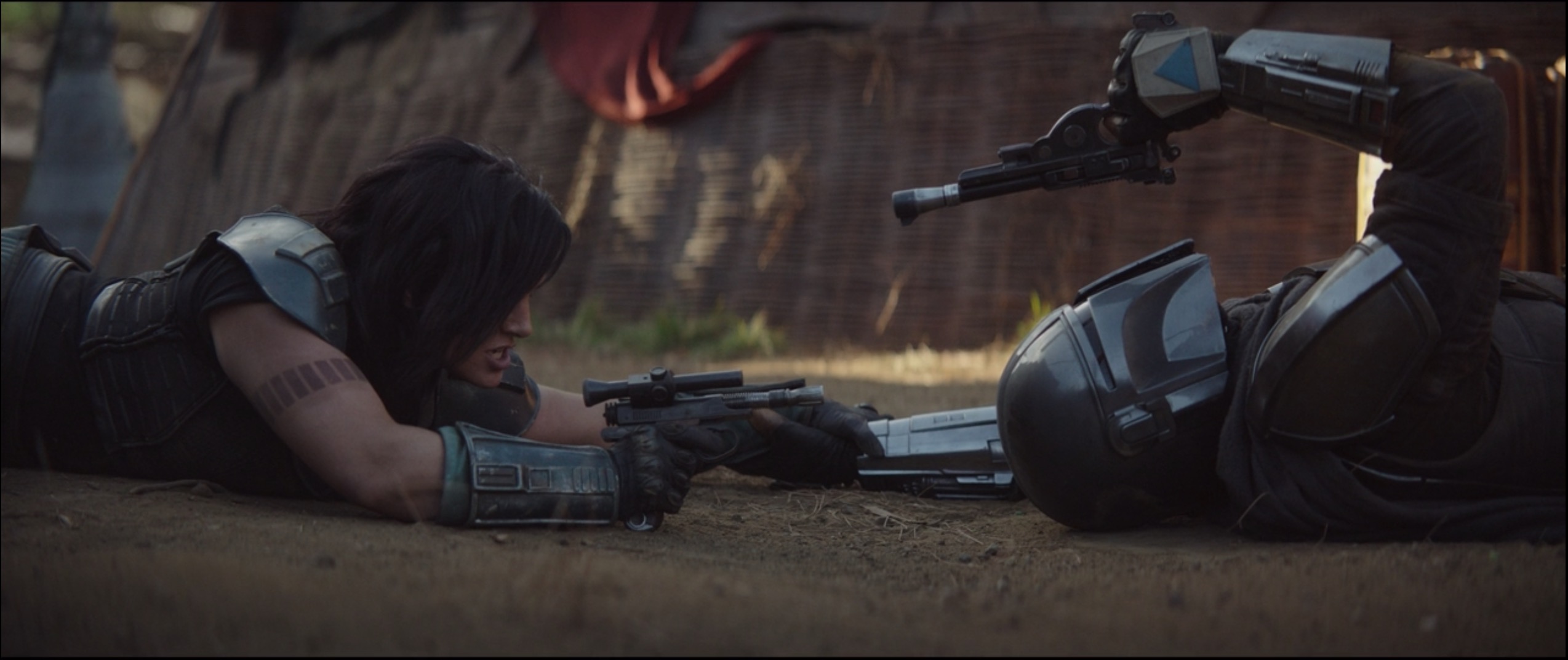
3. BlasTech E-11 blaster rifle
Another blaster that is synonymous with Star Wars is the Imperial E-11. Seen in all three movies of the original trilogy in both the hands of Stormtroopers, and turned against them by the heroes. This blaster used the British Sterling L2A3 submachinegun as a basis. Like the Sterling’s predecessor, the Sten gun, the most eye catching feature was the left side magazine.

The E-11 did away with that, only having a very short stubby magazine as a powercell. That simple change did a lot to change the look, but beyond that fins were built to cover the most visible top part of the heat shield, and scopes from Sherman tank guns were fitted on top by way of a specially installed rail for the E-11.
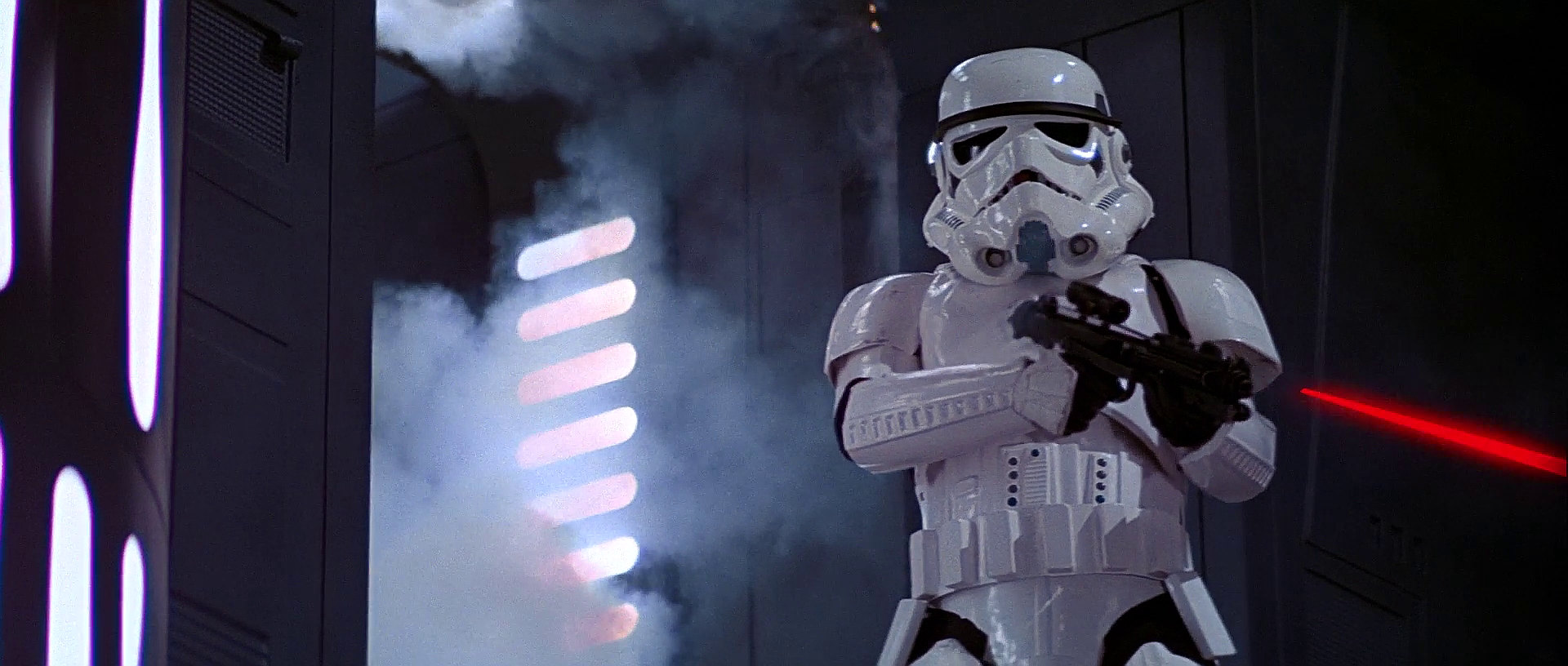
I want to take a quick aside to give a special mention to rebel DH-17 blasters, since they also used the L2A3s as a basis, and managed to look very different from the opposed E-11s by the addition of a large metal cover that replaced the entire original heat shield, and the mounting of the distinct and cool in its own right Armson OEG gunsight.

4. Boba Fett’s EE-3 carbine
This blaster first appeared in Empire Strikes Back, where visually it only looks so-so. Not great, not distracting.

When it comes back in Return Of The Jedi however, it has gotten a major glowup and become a fantastic and mean looking blaster.

Based on a real life Webley & Scott 37mm flare gun, it starts out with a promising foundation.

The basic silhouette resembles a revolver at a glance, but with a stock that is unusual even by pistol stock standards, and a massive barrel. The original barrel has been elongated and given cooling fins to create the appearance of a blaster carbine that almost certainly has a disintegration setting.
5. SE-14r
The SR-14 series of blaster had its first appearance all the way back in A New Hope. Despite the bartender’s protests it was brought out during the altercation between Luke and a pair of low lives in the Mos Eisley cantina.

The SE-14 is based on a lesser known Swiss submachinegun, but it goes a long way to change the shape further by entirely removing both the stock and barrel, along with removing the magazine.

The result is a blaster that is vaguely handgun sized but doesn’t resemble any real handgun. My favorite version of the SE-14 is the SE-14r used by Lando Calrissian in the Solo movie. It is chrome plated, and the scope has been moved forward a bit to make the entire thing look a bit more properly put together. It has a mystery muzzle device which I assume is for shooting down police helicopters.

Overall a completely fitting blaster for a character that wears a bright yellow shirt to a gunfight.
Now on to some of the low points in blaster props.
1.Sonn-Blas SE-44C blaster pistol
The SE-44 first shows up in The Force Awakens, and it is almost like a summary of all the things not to do to design a good blaster. The basis is a Glock pistol, which is polymer and distinct looking.

A Glock is a pistol designed too late to have shown up in the original trilogy (technically possible for ROTJ, but unreasonable). What is used to disguise the pistol is even worse, its just an off the shelf carbine conversion kit for real Glocks.

Most examples of the SE-44 have the conversion kit be colored white, prominently signaling that it is polymer instead of metal, and allowing the audience to get a good look at the picatinny rails it has installed. Up top there is a tiny front sight block from an AR-15. I don’t know if it is a casting or a 3D print, but aside from the downsizing it is clearly an exact copy, even including the gasblock. It’s kind of amazing because these miniature sights were not something taken off the shelf due to laziness, but something that must have been custom built or specifically sourced. Sticking some sort of scope or scope-like object up top would have been less work and looked better. All around the SE-44 is just a dud of a blaster.
2. Sonn-Blas F-11D blaster rifles
A blaster based on the iconic E-11, what could go wrong?

Just like the SE-44, it has a lot of white colored parts to give it a very plastic iPhone aesthetic. Out of place in Star Wars, and specifically weirdly out of place for an Empire that was supposed to have been defeated and is surviving on the rim. Some of the F-11Ds are fitted with stocks, which exacerbates the problem by making the buttstock also be visibly plastic and coloring the cheek riser white. Normally I’m not going to focus on realism when it comes to blaster bits in Star Wars, but it is impossible not to notice the cheekriser. Look at that cheek riser, and then look at First Order Stormtrooper helmets.

A stock is bad enough with Stormtrooper helmets, but a riser is just preposterous and most importantly: Distracting to look at.
3. Andor’s Rebel AK blasters
During the Aldhani raid, the rebels use blasters that are largely made from underfolding AK rifles.

Strangely a lot of work has been done to the rear of the props by incorporating MP-40 receivers to them, but it does almost nothing to change the overall silhouette. The most recognizable parts of the guns like the the handguard, gastube, and the sights are almost untouched. While there is some kind of filler material inside the triangle of the frontsight, all it really does is draw attention to the original shape rather than disguise it. The magazines are either 20 round AK magazines with very thin disguising, or prop magazines that follow the same shape as real ones. In any case, the final result is a blaster that is recognizable as a specific real world gun to even a casual observer.

Perhaps the idea was that in real life there is a connotation between rebels and AKs, and the Andor show wanted to leverage that, but honestly the show wouldn’t have suffered if they’d used something else. I still would have believed I was looking at rebels if they were using something more Star War appropriate.
4. BlasTech DLT-19 heavy blaster rifle
Going all the way back to A New Hope, the DLT-19 has always bugged me for how conspicuous the basis is. If you have any interest in World War 2, you’ve seen an MG-34.

It is a very memorable looking machinegun, and the DLT-19 does almost nothing to disguise it. There are a few cooling type fins added, which does give it some visual commonality with the E-11, but otherwise it’s just an MG-34.

The bipod is even still attached in A New Hope.
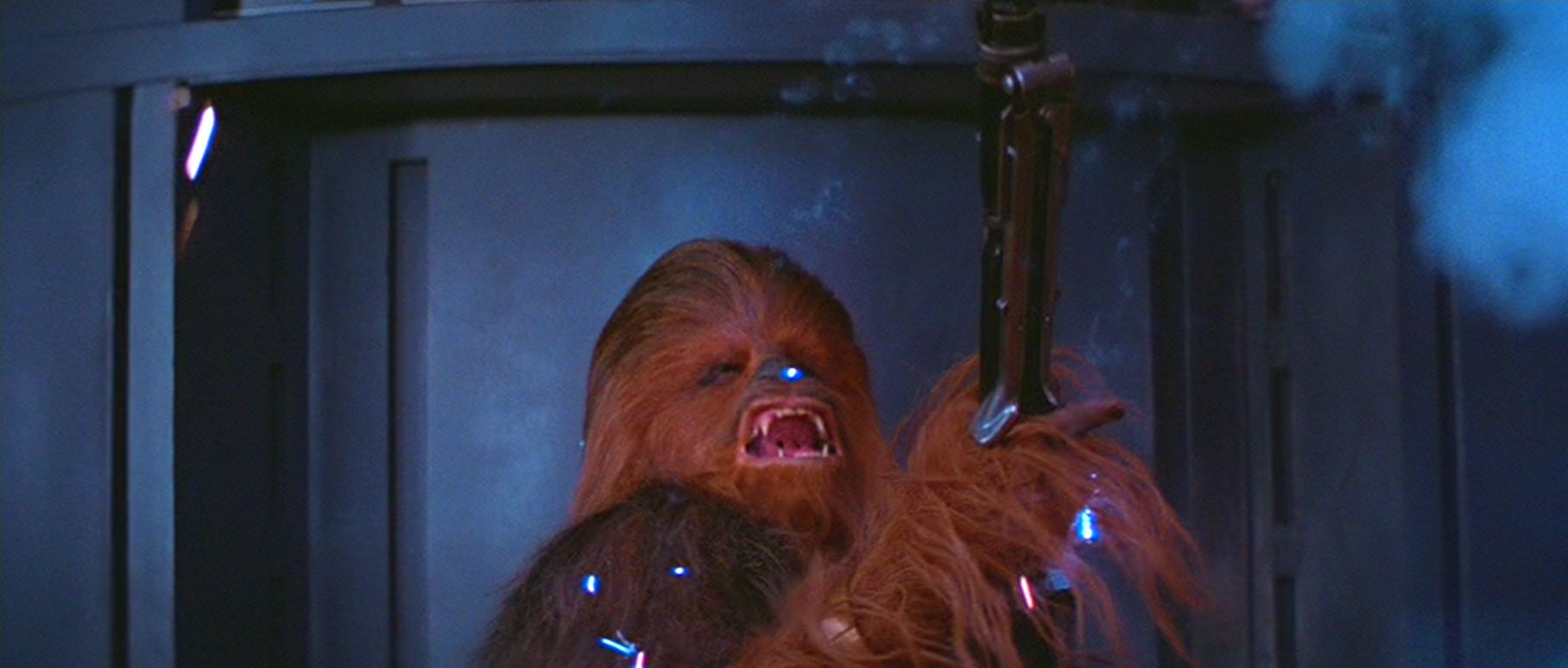
The DLT-19 comes back for a cameo in the hands of a bounty hunter in Empire Strikes Back, but its real next appearance is in Rogue One.

There the bipod has finally been removed, a scope (which appears unusable with an Imperial helmet on), and various accessories resembling lights or aiming devices have been attached around the barrel shroud. An improvement, but still pretty underwhelming to take a well known and distinct weapon, and make almost no attempt to disguise it.
5. M-45 Repeating Ion Blaster
The M-45 is similarly egregious for taking a well known real weapon, the M60, and basically doing nothing to hide it.

While the barrel has an appropriate looking sleeve fitted over the M-45, the blaster is mostly viewed with the trigger and receiver in view, betraying exactly what it is.

I’m well aware that this is very likely a visual reference to Full Metal Jacket.
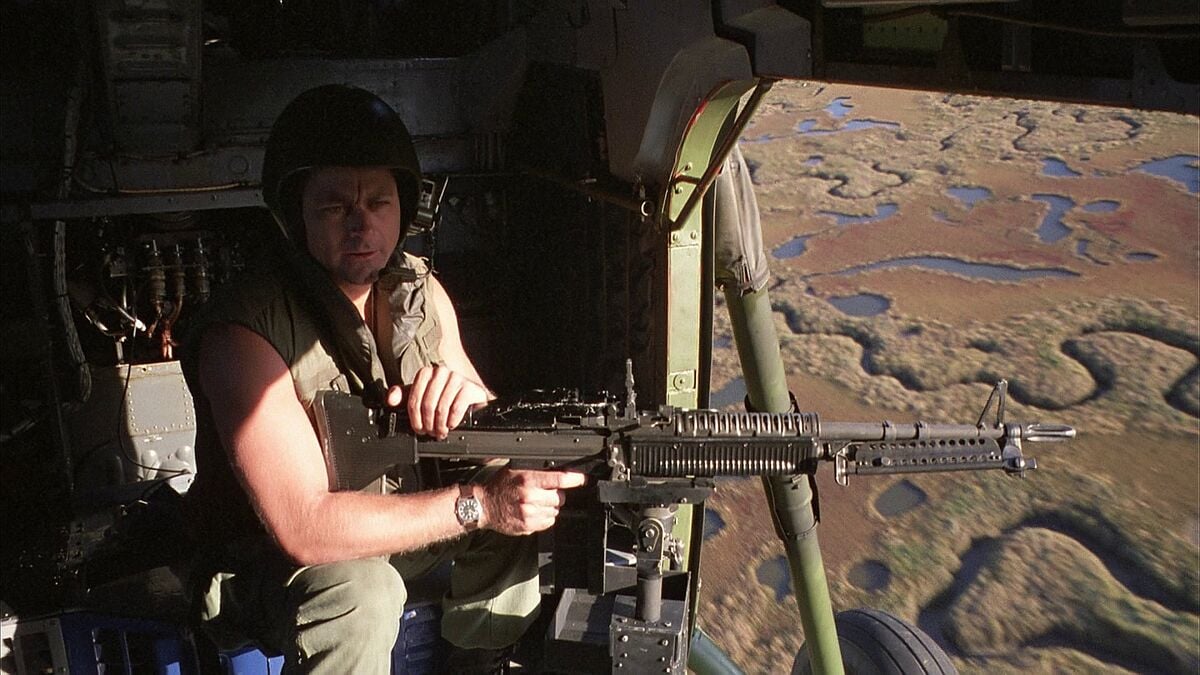

I like Star Wars to be Star Wars, and keep it away from so blatantly incorporating out of place props for the sake of a reference.
That ends my list, and dive into what I think are some of the best and worst Star Wars blasters.
A huge thanks to imfdb who I used for research, and from whom I shamelessly took photos from to write this up with.
This post is also an article on my blog and I encourage you to take a look, I've got lots of other stuff there too.








































